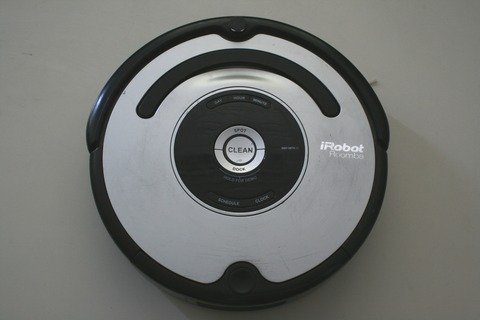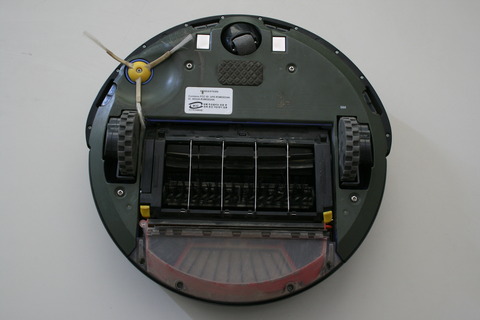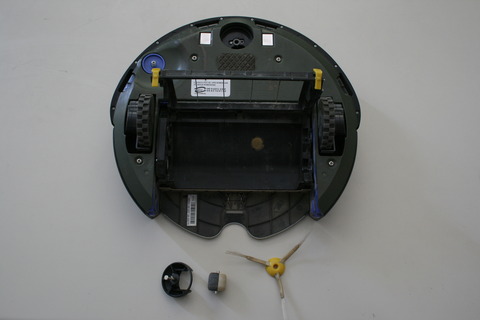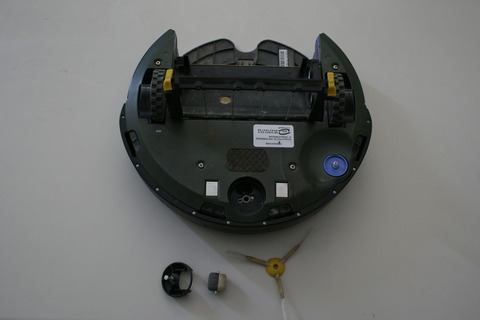Difference between revisions of "Disassembling a Roomba 560"
m |
|||
| Line 11: | Line 11: | ||
Image:Roomba_2.JPG | Bottom view. This is more interesting, as you can see (almost) all the moving parts, i.e., the two actuated wheels (bigger), the idler wheel (on top), the two rotating brushes, and the side brush used to catch dirt from corners. The "almost" is due to the fact that the Roomba also sports a small fan in the dust compartment (the only real vacuuming action occurs there) and a motor that lifts the whole brush module when the robot is on a carpet. | Image:Roomba_2.JPG | Bottom view. This is more interesting, as you can see (almost) all the moving parts, i.e., the two actuated wheels (bigger), the idler wheel (on top), the two rotating brushes, and the side brush used to catch dirt from corners. The "almost" is due to the fact that the Roomba also sports a small fan in the dust compartment (the only real vacuuming action occurs there) and a motor that lifts the whole brush module when the robot is on a carpet. | ||
Image:Roomba_3.JPG | The removable elements of the Roomba: two rotating brushes and the dust compartment. The latter includes a small fan, which receives power from the two clamp-like contacts visible on the underside of the robot, and a red element (shown in its open position by the picture) supporting a dust filter. | Image:Roomba_3.JPG | The removable elements of the Roomba: two rotating brushes and the dust compartment. The latter includes a small fan, which receives power from the two clamp-like contacts visible on the underside of the robot, and a red element (shown in its open position by the picture) supporting a dust filter. | ||
| − | Image:Roomba_5.JPG | Two other | + | Image:Roomba_5.JPG | Two other elements that are easily removed are the idler wheel assembly (wheel and socket, both removed by simply pulling) and the side brush (held in place by a screw). |
| − | Image:Roomba_4.JPG | Another view of the front wheel assembly, the side brush and the underside of the robot. At the bottom of the wheel socket you can see an emitter and a receiver, used to detect if the black/white wheel is actually rotating. | + | Image:Roomba_4.JPG | Another view of the front wheel assembly, the side brush and the underside of the robot. At the bottom of the wheel socket you can see an emitter and a receiver, used to detect if the black/white wheel is actually rotating or is stuck. |
</gallery> | </gallery> | ||
| Line 18: | Line 18: | ||
To get to the electromechanical elements of the robot, you have to remove the bottom cover (as we will see later, electronics is accessed from the top instead). | To get to the electromechanical elements of the robot, you have to remove the bottom cover (as we will see later, electronics is accessed from the top instead). | ||
<gallery widths=480px heights=320px perrow=3> | <gallery widths=480px heights=320px perrow=3> | ||
| + | Image:Roomba_6.JPG | Four captive screws hold in place the bottom cover. Removing it exposes the battery and exposes some additional electromechanical systems (enclosed in blue plastic cases). | ||
| + | Image:Roomba_7.JPG | To remove the battery, simply pull it out using the lateral cloth handles. The contacts on the battery are flat and, as we will see later on, touch small elastic plates directly fitted to the main circuit board. These plates pass through a cutout in the upper shell of the robot, and here are seen exposed. | ||
| + | |||
| + | |||
| + | |||
| + | |||
</gallery> | </gallery> | ||
Revision as of 14:50, 10 March 2010
This page is dedicated to the disassembly of a Roomba 560 vacuuming robot. Its purpose is to provide AIRLab users (or anyone else) wanting to hack a Roomba with a guide to the process, so that they can plan their work easily. Other Roomba 500-series models should be similar to the one featured in this page.
Please note that the robot we have taken apart was well-used, so you will see a fair bit of dust and dirt on the parts... all for the sake of realism. (Just joking: simply, that was a broken robot we could spare in case the process proved to be fatal :-) )
If you click on any of the images below, you will be taken to its own AIRWiki page, where you will be able to download the file. However, the files are NOT high-resolution (480x320 pixels: on this page they are shown at full resolution). You can download the high-resolution originals of the images (and some additional image not shown by this AIRWiki page) from here. Note that the originals are 3888x2592 pixels, and each of them weighs in at 3-5MB.
Before dissection
Here you can see the Roomba 560 before any disassembling occurred.
Bottom view. This is more interesting, as you can see (almost) all the moving parts, i.e., the two actuated wheels (bigger), the idler wheel (on top), the two rotating brushes, and the side brush used to catch dirt from corners. The "almost" is due to the fact that the Roomba also sports a small fan in the dust compartment (the only real vacuuming action occurs there) and a motor that lifts the whole brush module when the robot is on a carpet.
Removing the bottom cover
To get to the electromechanical elements of the robot, you have to remove the bottom cover (as we will see later, electronics is accessed from the top instead).
To remove the battery, simply pull it out using the lateral cloth handles. The contacts on the battery are flat and, as we will see later on, touch small elastic plates directly fitted to the main circuit board. These plates pass through a cutout in the upper shell of the robot, and here are seen exposed.






